Past Exhibitions
- Going Ape for the Year of the Monkey Part 5: Monkey Motifs in Daily Life
- December 15, 2015 - January 24, 2016
Playful and sometimes highly innovative in design, Japanese handcrafts from the Edo Period (1603-1868) with a monkey motif often reference proverbs and sayings. Meanwhile, in Qing Dynasty (1644-1912) and modern China, people decorated their homes with hanging scrolls featuring auspicious patterns of monkeys paired with flowers and fruit. In Japan images of monkeys on objects used in daily life often signified banishment of bad luck or evil spirits, incorporating puns on saru, the Japanese word for monkey, and its synonym saru, "to depart." Others symbolized longevity, success, or other aspects of good fortune. We hope you enjoy the many "monkeys of good omen" in this section, which give unique expression to wishes and hopes that are every bit as universal today as they were when these objects were made.
Special Feature: Mori Sosen, Master of the Monkey Genre
Among the Edo-era (1603-1868) artists, Mori Sosen (1747-1821) was the undisputed master of the monkey painting. He studied the techniques of the Kanō School and the life sketches of Maruyama Ōkyo, and made a tremendous impact in Osaka art circles with his animal paintings featuring delicate renderings of fur. Particularly renowned were his stunningly lifelike portrayals of monkeys, which sparked stories that he had spent years in the mountains researching them in their natural habitat. Despite his consummate mastery of technique, his paintings are never overworked, maintaining a light touch and bubbling with friendly warmth.












